Two years after seizing power in a coup, Min Aung Hlaing’s junta in Myanmar continues to be ensnared in a civil war that shows no signs of abating.
Since the military crushed the mass strikes that emerged in opposition to the coup, tens of thousands of armed youth, small farmers and workers (people’s defence forces, or PDFs), alongside ethnic armed organisations (EAOs) have clashed with the Tatmadaw, Myanmar’s military, in parts of Chin, Shan, Karen and Kachin states, across the Sagaing region and throughout the Irrawaddy delta.
The Tatmadaw is reportedly suffering from a lack of resources and morale problems that are undermining its ability to fight. As many as 8,000 soldiers and police are thought to have been killed by opposition groups, while an estimated 10,000 have defected to the opposition. By contrast, EAO and PDF forces in Chin, Karen and Kachin states are now advancing into previously junta-controlled territory and setting up interim local governments as they secure control over the newly won territories.
The junta has waged an ongoing campaign of terror against its opponents. More than 16,500 people have been arrested since the coup and more than 13,000 of them remain in prison, according to the Assistance Association for Political Prisoners. The AAPP estimates that more than 2,500 people have been killed since the junta took power.
Junta-run courts have imposed the death penalty on 138 people, including 41 in absentia. In July, four political prisoners accused of carrying out “terror acts” against the military government were hanged. The executions are the first to be carried out in Myanmar since the late 1980s. In November, seven Dagon University students were sentenced to death on similar charges. It is unclear when the students will be executed.
“The junta is targeting students and young people because we have been at the forefront of resistance to the regime”, Min,* a student activist and member of the University of Yangon Students’ Union, tells Red Flag from Myanmar. “The purpose of the trials and executions is to strike fear in the hearts of those who wish to resist the regime.”
But Min says it is the regime that lives in fear. “The junta is terrified by the prospect of young people leading a revolution against the regime. The junta is despised and hated by the majority of people in Myanmar. The junta may be in power, but they are not in control.”
Min has been on the run from the Tatmadaw since early April 2021, after arrest warrants were issued for him and other student activists on the charge of inciting mutiny in the armed forces. Since then, Min has been based in the “liberated areas”—territory in the borderlands that is controlled by EAOs and no longer under the control of the Tatmadaw. He has recently returned to the central lowlands but remains in hiding.
“Because of the terror, student activist networks are scattered and isolated all throughout the countryside”, Min says. “And the situation in the major cities makes it impossible to organise protests that won’t be violently crushed by the security forces.”
It is a similar story in Yangon’s industrial zones. “The factory managers attempt to rule through fear and terror”, Ko Maung,* an independent researcher and labour activist, tells Red Flag. “If workers have grievances, there is the threat that if they protest, the managers will call in the military. The fear has a huge impact on the confidence of workers to organise and resist.”
Ko Maung and many labour activists were forced to flee to the Thailand-Myanmar border after the junta outlawed a number of trade unions and issued arrest warrants for trade union leaders associated with the illegal unions. But in an attempt to legitimise the post-coup arrangement, the junta maintains that unions, unionisation and collective bargaining remain legal, which means that a number of trade unions remain legal. It has provided limited space through which workers have continued to organise collectively for improved wages and conditions.
In garment factories across Yangon’s industrial zones, where factory-level unions maintain strength and cohesion, Ko Maung says that the threat of strike action is enough to ward off attacks from factory managers and force concessions. “The bosses don’t dare force these workers to do overtime”, he says. “Because workers respond by saying: ‘If you call overtime, we will go on strike!’”
The residual class confidence that Ko Maung points to is the legacy of more than a decade of union organising that took place under civilian-military rule. The expansion of the rights to strike and form a trade union created space for activists to create hundreds of new unions during this period. And unlike countries in which trade unions are well established, with entrenched bureaucracies and passive leaders, many of these unions were established through wildcat strikes and riots.
The period of civilian-military rule also created a combative environment among students, who fought to re-establish student unions, which had been banned under the previous junta. This activism led to the creation of political associations in which students could discuss and debate political topics openly for the first time in more than five decades.
A number of more explicitly radical forums also flourished, including Marxist discussion circles. These groups have become the main organisations on the far left in Myanmar today: the Stalinist-Maoist Leftist Youth Organisation, the Trotskyist group Revolutionary Marxism and the Social Democratic United Front (SDUF). Alongside the militant sections of student and trade unions, these groups were crucial to calling the early demonstrations in opposition to the coup, which in turn acted as the social detonator for the mass strikes that followed.
Aung Maung,* a member of the SDUF, says that political experience meant that the radical left was able to seize the possibilities opened up by the coup. “We knew that if we provide a lead, mass resistance will follow”, he explains. “And if there was mass resistance, we knew there would be a revolution to stop the coup, a revolution to completely abolish the junta, the military clique and the military-bureaucratic capitalism.”
Min Aung Hlaing’s junta represents a wing of the Burmese ruling class: the leading personnel of the Tatmadaw, military-controlled conglomerates, Burmese state capitalists, cronies subservient to state patronage networks and the most reactionary sections of the Buddhist clergy and the far right.
The dominant perspective on the left in Myanmar is that armed struggle can act as a substitute for the social power of the working class in overthrowing the junta. It is partly informed by the conclusion drawn by many after the collapse of the February and March strike wave: the working class does not have the power to defeat Min Aung Hlaing’s regime; only armed struggle can win.
The important exception is the Trotskyist group Revolutionary Marxism. They argue that the inability of the February and March strike wave to topple the junta was due to the absence of a political leadership that could extend the strike movement into broader sections of the working class, transform the movement into a fight for control over production and promote widespread mutinies within the armed forces.
The key task for revolutionaries in Myanmar, they argue, must be to build a revolutionary Marxist party that can organise the most advanced workers to lead the mass of workers and draw behind them the broader masses (small farmers and ethnic minorities) in a revolution that not just overturns military rule but smashes the entire Burmese ruling class.
In a polemic with the Trotskyists written for the SDUF’s publication Social Democrat, Lin Htal Aung* argues that, to be successful, the struggle against the junta needs a cross-class alliance:
“The movement is a national liberation struggle in which the emerging bourgeoisie and some of the revolutionary national bourgeoisie joined forces [with the working class and small farmers] ... It is true that the revolution needs to build working-class leadership. But at the same time, the practical conditions demand that we fight for a form of democracy that is lower than workers’ democracy. Therefore, we are trying to build a revolutionary front that includes all classes.”
Marxists argue that social class divisions are irreconcilable and that political programs that express a desire for unity between workers and capitalists can only strengthen the hand of the ruling class while hamstringing the workers’ movement. But Lin Htal Aung argues that the movement against the junta “cannot have a political view that represents only one class”. This is precisely what he is proposing when he says that elements of the “revolutionary bourgeoisie” (the leading personnel of EAOs and associated parties) have the same interests as the classes that they oppress and exploit.
Only one class can become dominant in such a movement: either the capitalists, who want a form of democracy in which they can exploit and oppress the other classes, or the working class—leading other oppressed groups—which aims not only to establish democracy, but to overthrow the entire ruling class.
In an article for the publication The Struggle, Jack,* a member of Revolutionary Marxism, argues that in practice this perspective means abandoning the political independence of the working class: “Presenting reactionary elements to the public as the revolutionary class is a betrayal of the revolution. In other words, the interests of the working class are subsumed under the interests of a section of the bourgeoisie”.
Fighting for a perspective that maintains the political independence of the working class does not mean that an organisation will be able to gain a mass audience. Indeed, the government’s terror makes opposition in urban centres increasingly difficult and dangerous. But the ongoing resistance by workers—combined with ongoing flash mob demonstrations organised by young people—illustrates that there is still space for underground organising in the cities.
This is because the brutality that characterises Min Aung Hlaing’s junta is not only producing misery—it is also producing widespread anger and a desire for an alternative. If the situation shifts, a renewed mass movement in urban centres could develop.
Rahul Kyaw Ko Ko contributed to this article.
* Names changed.











